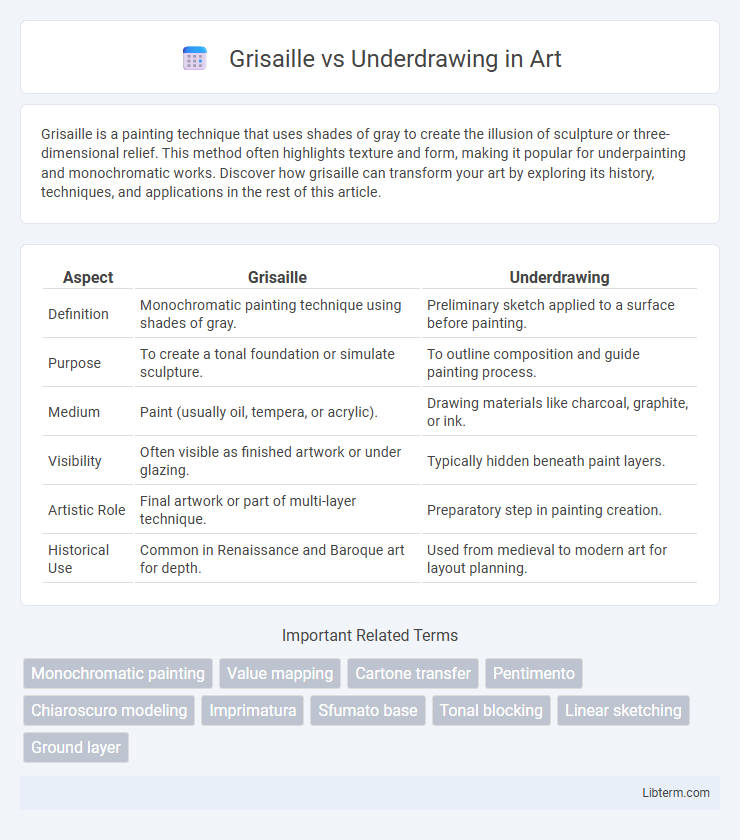Grisaille is a painting technique that uses shades of gray to create the illusion of sculpture or three-dimensional relief. This method often highlights texture and form, making it popular for underpainting and monochromatic works. Discover how grisaille can transform your art by exploring its history, techniques, and applications in the rest of this article.
Table of Comparison
| Aspect | Grisaille | Underdrawing |
|---|---|---|
| Definition | Monochromatic painting technique using shades of gray. | Preliminary sketch applied to a surface before painting. |
| Purpose | To create a tonal foundation or simulate sculpture. | To outline composition and guide painting process. |
| Medium | Paint (usually oil, tempera, or acrylic). | Drawing materials like charcoal, graphite, or ink. |
| Visibility | Often visible as finished artwork or under glazing. | Typically hidden beneath paint layers. |
| Artistic Role | Final artwork or part of multi-layer technique. | Preparatory step in painting creation. |
| Historical Use | Common in Renaissance and Baroque art for depth. | Used from medieval to modern art for layout planning. |
Introduction to Grisaille and Underdrawing
Grisaille is a monochromatic painting technique using shades of gray to simulate sculpture and create depth, often serving as an initial layer in oil painting. Underdrawing involves preliminary sketching directly on the support, guiding composition and details before painting begins. Both techniques are essential in the artistic process, with grisaille emphasizing tonal values and underdrawing focusing on structural design.
Historical Origins: Grisaille and Underdrawing
Grisaille, originating in 14th-century Europe, is a painting technique using shades of gray to mimic sculpture and create depth, predominantly employed in illuminated manuscripts and religious panel paintings. Underdrawing dates back to the early Renaissance, serving as a preparatory sketch on a painting surface to outline composition and detail before applying paint, visible through infrared reflectography in many historic artworks. Both techniques reflect distinct historical practices in art creation, with Grisaille emphasizing tonal modeling and Underdrawing focusing on structural planning.
Techniques Compared: Grisaille vs Underdrawing
Grisaille is a painting technique using shades of gray to create a monochromatic underpainting that establishes tonal values and depth, often serving as a base for color layers. Underdrawing involves detailed preliminary sketches made with dry media like charcoal or graphite directly onto the support to guide the composition and design before applying paint. While grisaille emphasizes tonal modeling in paint, underdrawing focuses on linear structure and planning, both crucial for accurate and cohesive artwork development.
Artistic Purposes: Establishing Form and Value
Grisaille and underdrawing both serve to establish form and value in artwork, but Grisaille involves a monochromatic painting technique that builds tonal variations directly on the surface, creating depth and volume with shades of gray. Underdrawing refers to preliminary sketches applied to the support, guiding composition and proportions while laying the groundwork for subsequent layers. Grisaille acts as a value study often retained or refined in the final piece, whereas underdrawing primarily functions as an invisible blueprint under paint layers.
Materials and Tools Used in Grisaille and Underdrawing
Grisaille technique primarily involves using monochromatic shades of gray, typically applied with oil paints or tempera on a primed surface, along with brushes designed for fine detail and blending. Underdrawing relies on materials like charcoal, graphite, or red chalk to sketch preliminary designs on canvas or panel, often utilizing styluses or fine-pointed drawing tools for precise outlines. Both methods require specialized tools tailored to their medium, with grisaille emphasizing paint handling and layering, while underdrawing focuses on accurate draftsmanship and line control.
Step-by-Step Process: Grisaille Method
Grisaille is a monochromatic painting technique using shades of gray to create depth and form, often employed as an underpainting layer in oil painting. The step-by-step process of the Grisaille method begins with a detailed underdrawing, typically done in charcoal or graphite, defining the composition's key shapes and shadows. Next, artists apply thin layers of gray paint--increasing tonal contrasts gradually--to model volume and structure before adding full color glazes or finishing touches.
Step-by-Step Process: Underdrawing Technique
Underdrawing technique involves creating a preliminary sketch on the painting surface, often using graphite, charcoal, or ink, to outline composition and major elements before applying paint. Artists employ various methods like freehand drawing, grid transfer, or tracing to achieve accurate proportions and detail placement. This foundational step enables precise guidance during layers of paint application, crucial for both grisaille and color works.
Effects on Final Painting: Visual Impact and Longevity
Grisaille creates a monochromatic underpainting that enhances the depth and tonal structure, resulting in a visually cohesive and luminous final artwork. Underdrawing serves as a precise blueprint, guiding composition but with less influence on surface texture or luminosity, allowing for greater color layering and variation. Grisaille often contributes to greater longevity by providing a stable tonal foundation that resists fading, while underdrawing's durability depends on the medium and quality of materials used beneath the paint layers.
Master Artists Known for Grisaille and Underdrawing
Master artists such as Jan van Eyck and Leonardo da Vinci excelled in underdrawing techniques, using precise preliminary sketches to establish composition and detail before painting. Grisaille, a monochromatic painting technique often employed by artists like Albrecht Durer and Jean Clouet, was used to create sculptural effects and tonal studies in their works. These methods demonstrate the blend of meticulous planning and tonal mastery pivotal in Renaissance and Northern Renaissance art practices.
Choosing Between Grisaille and Underdrawing: Which is Best?
Grisaille involves creating a monochromatic underpainting in shades of gray to establish values and forms, while underdrawing serves as a preliminary sketch guiding the entire painting process. Choosing between grisaille and underdrawing depends on the desired level of tonal development and detail precision; grisaille provides a strong tonal foundation ideal for complex lighting, whereas underdrawing offers flexibility for compositional adjustments. Artists prioritizing depth and value accuracy typically prefer grisaille, whereas those emphasizing design structure and line work often opt for detailed underdrawing.
Grisaille Infographic

 libterm.com
libterm.com